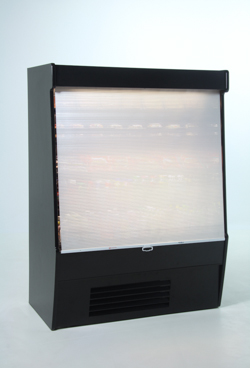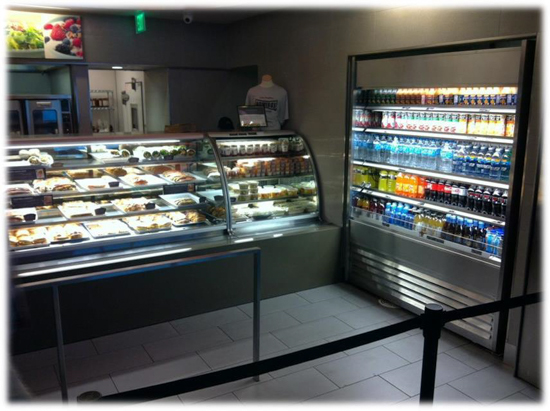Content sponsored by: Structural Concepts
Today’s more energy-efficient refrigerated grab-and-go displays provide unrestricted access and unparalleled food presentation to stimulate sales.
 Night covers provide a physical barrier to keep cold air inside a refrigerated grab-and-go display case when the operation closes for the day.As the grab-and-go food segment keeps growing, the need for attractive, efficient refrigerated display cases continues to rise.
Night covers provide a physical barrier to keep cold air inside a refrigerated grab-and-go display case when the operation closes for the day.As the grab-and-go food segment keeps growing, the need for attractive, efficient refrigerated display cases continues to rise.
According to a survey by Chicago research firm Technomic, 69 percent of consumers purchase grab-and-go foods due to the added convenience, and approximately 45 percent of restaurant customers seek more grab-and-go food options.
As a result, a growing number of foodservice operators and retailers find that providing fresh foods to their customers in easily accessed refrigerated displays can help drive impulse sales and increase profits. “The grab-and-go category has been the beneficiary of many of the initiatives put forth by leading retailers in recent years,” says Wade Hanson, principal at Technomic.
Improved consumer perceptions of grab-and-go foods, in addition to increased time constraints, drive growth in the segment, according to Technomic. The top triggers that prompt consumers to purchase grab-and-go items include more options, less time to cook, higher quality offerings, less time to dine in at restaurants, and improvement in grab-and-go packaging. In other words, grab-and-go items are becoming part of consumers’ routines.
Proper refrigeration plays an essential role in keeping grab-and-go food items at safe temperatures and preserving product quality and freshness. Because refrigerated grab-and-go displays require an open design for easy access and effective food merchandising, these units’ refrigeration systems work harder than displays with doors. Although open grab-and-go displays utilize more energy, these units can stimulate impulse sales in a way that reach-in refrigerators with doors can’t.
 Some foodservice operators report sales increases of at least 50 percent after they switched to an open front grab-and-go display from a door unit.Some operators report sales increases of at least 50 percent when switching from a door unit to an open front grab-and-go display. “Not only are these displays clean, but they include air curtains, which allow customers to see and touch the merchandise,” says Parviz Monsefan, director of food and beverage at the Hyatt Regency Coconut Point Resort & Spa. "This encourages impulse sales, since guests are not just looking at product behind a glass door.”
Some foodservice operators report sales increases of at least 50 percent after they switched to an open front grab-and-go display from a door unit.Some operators report sales increases of at least 50 percent when switching from a door unit to an open front grab-and-go display. “Not only are these displays clean, but they include air curtains, which allow customers to see and touch the merchandise,” says Parviz Monsefan, director of food and beverage at the Hyatt Regency Coconut Point Resort & Spa. "This encourages impulse sales, since guests are not just looking at product behind a glass door.”
It’s important to choose refrigerated grab-and-go displays that don’t compromise food presentation or the operation as a whole in order to reduce energy consumption. Features like hot gas condensate pans in lieu of electric pans and rifled copper tubing help to significantly lower daily energy consumption in refrigerated display equipment, especially grab-and-go models.
Effective January 1, 2012, the Department of Energy institutionalized a standard that set limits on the daily energy consumption of commercial refrigeration equipment to reduce the impact this equipment group has on the environment. While some refrigerated grab-and-go displays meet the DOE’s standard, others exceed it to save the operator significant energy dollars.
 Placement of refrigerated grab-and-go units can drive impulse sales for foodservice operators across all industry segments.
Placement of refrigerated grab-and-go units can drive impulse sales for foodservice operators across all industry segments.
For example, one manufacturer’s grab-and-go display lowers daily energy consumption to 20 kWh/day, exceeding the DOE’s standard of 30 kWh/day. This exceeds the DOE’s limits by more than 30 percent and is at least a 50 percent reduction over the manufacturer’s previous design. This type of innovation represents the level of advancements that are available to significantly reduce energy use with open display units.
When purchasing a grab-and-go display, it’s also important to consider the total life cycle costs of the equipment and not just the initial purchase price. When factoring in the energy savings that the equipment offers, it doesn’t take long for some models to achieve a decent return on investment just with the annual energy saved. Add this return to the increase in revenue the display generates and the result is a healthier bottom line.
Open refrigerated grab-and-go cases are available that cost less than half as much to operate annually compared to equivalent models. “Energy-efficient open displays can pay for themselves over time,” says David Zabrowski, general manager at Fisher-Nickel Inc./Food Service Technology Center. “In foodservice operations with a 5 percent margin, every $1 of energy saved is worth $20 in sales.”
Experts say operators can perform a few simple tasks to save energy with open grab-and-go display units. For example, proper clearance around the unit is necessary to control energy use. “In a number of retail operations and restaurants, open grab-and-go cases are located in tight spaces with no breathing room,” says Zabrowski. “The result is the area around the condenser gets very hot and the unit has to work harder to keep the chilled space at proper temperatures.”
Ventilation also is a consideration when positioning an open refrigerated display case. “We tested a grab-and-go refrigerated case that was in the back corner of a juice bar,” Zabrowski says. “This area had minimal ventilation.”
Because the ventilation wasn’t sized appropriately for the added heat load of the unit, the operator had to relocate the display case. “These units need to have cool air in the vicinity to compensate for the heat that’s pulled out of the refrigerated space,” Zabrowski said.
Adding night covers represents another way to help minimize energy loss. The covers provide a physical barrier to keep cold air inside the unit when the operation closes for the day. “Grab-and-go cases that utilize LED lighting, as opposed to fluorescent, also can dramatically reduce energy use,” Zabrowski said. “These lights generate less heat, which adds to the case’s cooling efficiency.”
For more than a decade, Southern California Edison Co. in Irwindale, Calif., has been involved with projects funded by the DOE and California Energy Commission to improve air curtain performance in refrigerated cases. “Any time the mixing of air and entrance of warm, moist air into these cases can be reduced, it is beneficial to energy use,” said Scott Mitchell, thermal testing lead at the Technology Test Center of Southern California Edison Co.
 Proper clearance around open grab-and-go display units will help control energy use. Units placed in tight spaces restrict the unit’s breathing room, which means the condenser has to work harder to maintain proper food temperatures.Compressors in refrigerated grab-and-go cases utilize large amounts of energy, however some newer systems operate more efficiently. “We recommend that operators use compressors with a variable capacity ability to match refrigeration loads,” Mitchell said.
Proper clearance around open grab-and-go display units will help control energy use. Units placed in tight spaces restrict the unit’s breathing room, which means the condenser has to work harder to maintain proper food temperatures.Compressors in refrigerated grab-and-go cases utilize large amounts of energy, however some newer systems operate more efficiently. “We recommend that operators use compressors with a variable capacity ability to match refrigeration loads,” Mitchell said.
In addition to not blocking airflow around the refrigerated unit, operators should follow manufacturer load lines. Overloading display cases and stacking product impedes airflow and compromises the unit’s energy efficiency. “Also, leaking product can be an issue, if substances are clogging the evaporator coil,” Mitchell says. “This area must be kept clean for optimum efficiency.”
With today’s technology, the energy consumption gap between a refrigerated reach-in door unit and a grab-and-go display has narrowed significantly. Solutions are available that reduce the daily energy consumption of this group of equipment, which allows more operators to take advantage of the many benefits open grab-and-go cases offer.
“As consumers gravitate toward fresh prepared options, such as made-to-order meals, they are being met by a higher quality grab-and-go selection that appeals to their need for convenience,” Hanson says.




